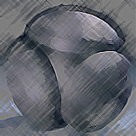NE Scotland Regional Research Framework - Neolithic
 The Early Neolithic (4000 BC – 3300 BC) is characterised by the appearance of large rectangular halls and cursus monuments. Burial monuments include long and round barrows and cairns. The first pottery appears, and artefact types include polished stone axe-heads. The Late Neolithic (3300 BC – 2500 BC) sees the widespread appearance of new burial practices and material culture, including Grooved Ware pottery, carved stone balls and maceheads. Monument types include stone circles, henges and rock art.
The Early Neolithic (4000 BC – 3300 BC) is characterised by the appearance of large rectangular halls and cursus monuments. Burial monuments include long and round barrows and cairns. The first pottery appears, and artefact types include polished stone axe-heads. The Late Neolithic (3300 BC – 2500 BC) sees the widespread appearance of new burial practices and material culture, including Grooved Ware pottery, carved stone balls and maceheads. Monument types include stone circles, henges and rock art.
Research Agenda
The Agenda gives an overview of the principle themes that research should follow in NE Scotland for the Neolithic. Each research question directly relates to ScARF.
What is the overall pattern of settlement, land use and subsistence activity and how, and why does it change?
What was the nature of Middle and Late Neolithic habitation structures? In other words, are we dealing with a change in building techniques, away from the Early Neolithic rectangular, post/post and plank-built construction (as the Late Neolithic 'four poster' structures suggest) - and were these structures used in a different way from Early Neolithic houses?
What can be said about the nature of, and changes in, society from the evidence currently available? Clearly this part of Scotland became involved in the larger social changes from c 3000 BC onwards, but did the nature of society change? Why was this region the epicentre for the production and use of carved stone balls? How exactly were the large 'palisade' enclosures used? And how does the practice of creating and using rock art articulate with other expressions of belief and ritual practice?
How many of the timber/pit circles and henges or henge-like sites known from the aerial record actually belong to the Late Neolithic?
Relatively little is known about the use of animals in this part of Scotland, since bone assemblages do not survive well in the free-draining soils. There is a need to find many more, and larger, assemblages in order to improve our understanding of species exploitation and management techniques.
What prompted the initiation of flint mining on the Buchan Ridge Gravels? Could it have been a reaction to the existence of a flourishing specialist flintworking tradition in North Yorkshire?
The Littleour Grooved Ware assemblage needs to be re-dated, and the existing dates critically re-evaluated; and there is a general need to round up all the existing dating information about all Neolithic pottery in this region, to refine our developmental sequence.
The dating of Neolithic non-megalithic round mounds needs to be improved.
More examples of the 'four post' timber circle structures need to be excavated, to investigate their nature, use and relationship with other similarly-shaped structures elsewhere.
How many of the stone circles in this region date to the Neolithic?
The use and significance of cursus monuments and bank 'barrows' needs to be clarified.
